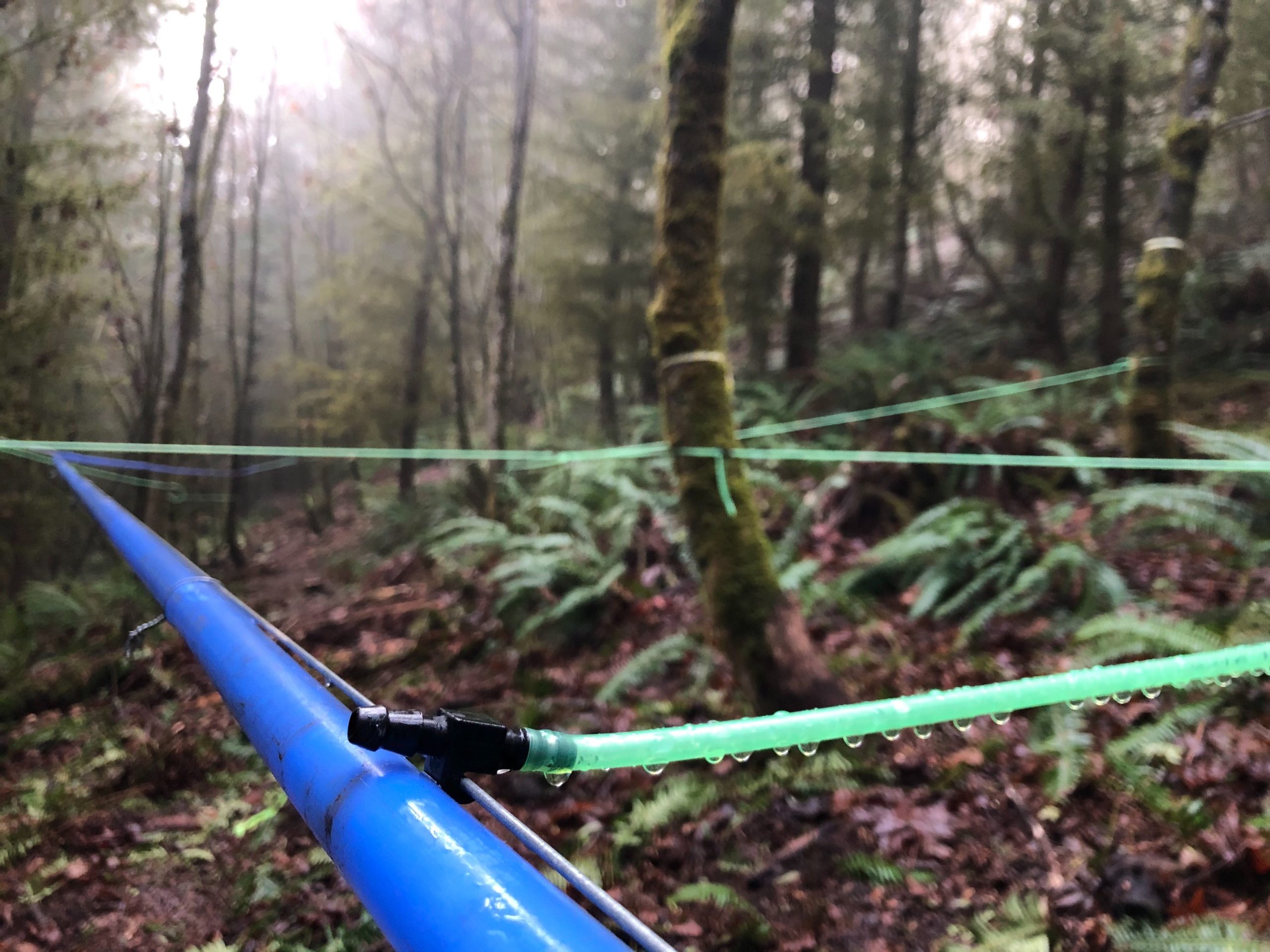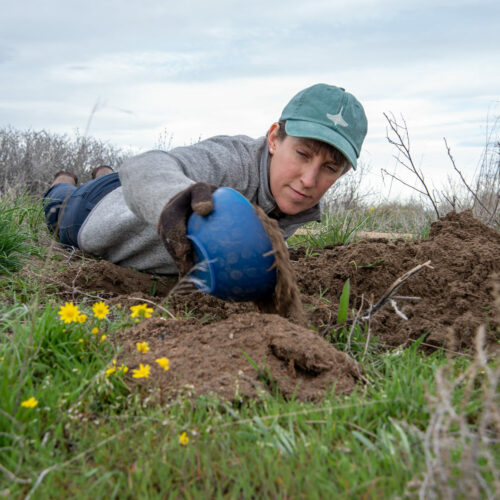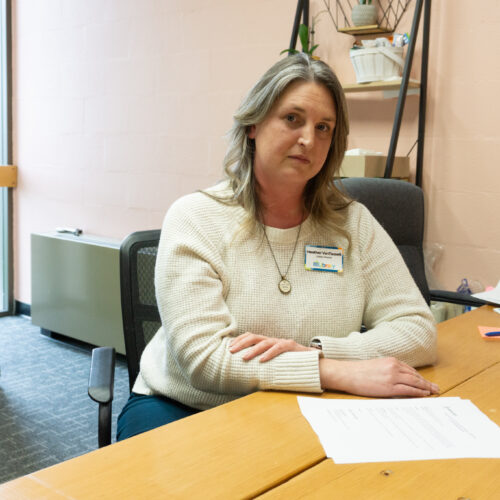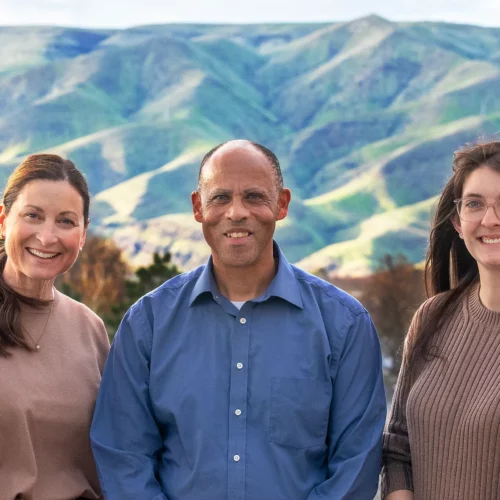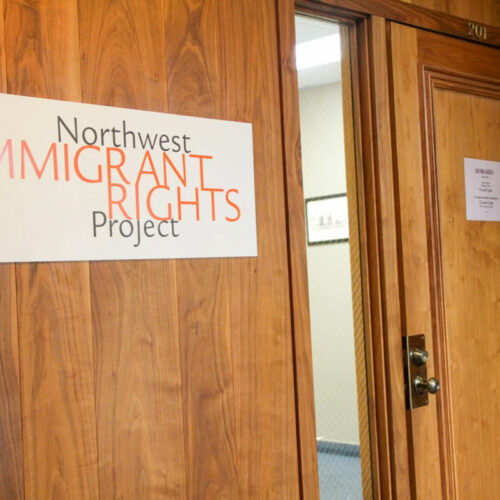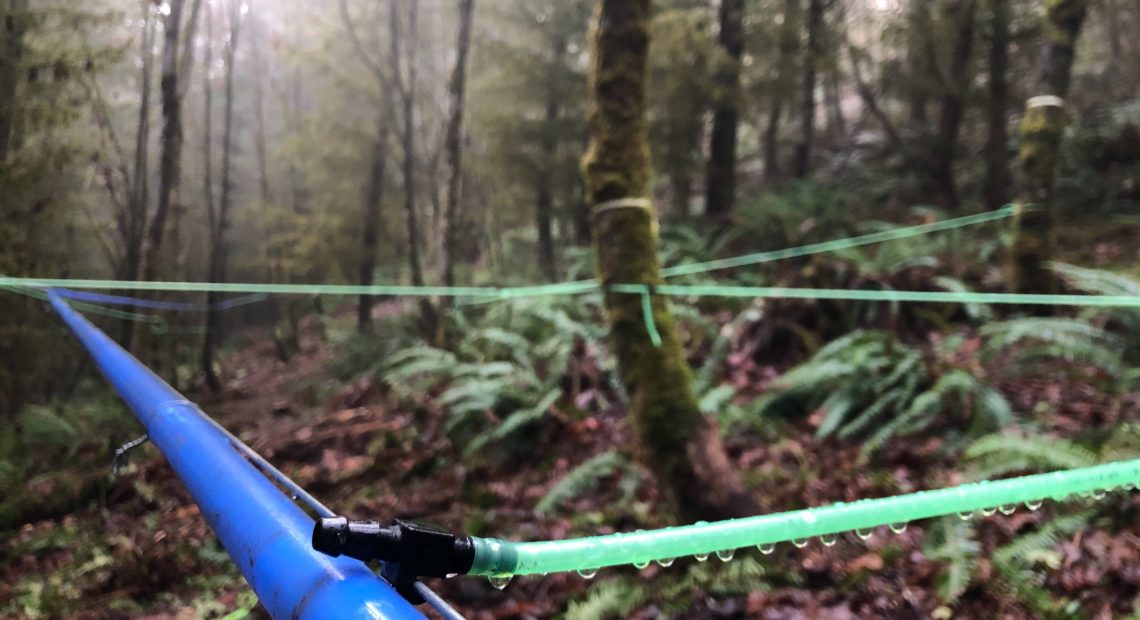
Bigleaf Maple Syrup Flows As Profits Drip From A Once-Maligned Northwest Tree
Listen
There’s probably more written on how to kill a bigleaf maple tree than how to grow one.
So says Neil McLeod of Neil’s Bigleaf Maple Syrup, out of the tiny northwestern Washington burg of Acme.
“It’s hard to kill,” McLeod says with a wry smile. “A great tree. Perfect weed.”
And then he adds, “It makes good syrup.”
I meet McLeod in his humid, densely-scented sugar barn. Puffy steam pours out of an evaporator through several big stacks and into the cold winter air. The damp perfume permeates his t-shirt and clouds up his glasses as he leans over the vats, inspecting them for any out-of-control foaming up.
McLeod has become intensely interested in how to better grow the West Coast’s native bigleaf maple tree — because he’s started tapping them by the hundreds for his boutique syrup business.
Growth Rings
Since 2011, McLeod cooked in the woods on his property using a 10-gallon pot over a propane ring. Now, he uses a $15,000 commercial evaporator and $10,000 reverse osmosis machine.
In his pantry McLeod keeps select bottles of his older vintages. Some are lighter colored, others are dark with the sap’s mineral sediment settled to the bottom.
In 2018, the family business made about 140 gallons of syrup. This year, he expects to pour on the sap and produce about 500 to 700 gallons.

Neil McLeod, owner of Neil’s Bigleaf Maple Syrup farm, keeps a close eye on his reducing sap for out of control foaming. CREDIT: Anna King/N3
To make just one gallon of finished syrup, he has to cook down 60 to 100 gallons of tree sap. That’s why Neil’s Bigleaf Maple Syrup is selling its product to restaurants for about $2 an ounce and why he dreams of big growth.
“You will be able to find it in a store near you soon, OK,” McLeod says.
Neil’s Bigleaf is a family business. Devin Day, McLeod’s son, is the company’s front man, charming chefs with syrup samples. He says the goal is to plant a lot more trees on the farm, and find new tapping ground.
“You could go find a very pristine piece of property full of maples, tap it and have your house paid off in just a few years,” he says. “That’s insane. Nobody even realizes that.”
Neil’s syrup is a drop in the bucket compared to the established East Coast and Canadian maple syrup industries that poured out a combined 15 million gallons worth each year. But this fresh Northwest product is finding a home with top chefs.
Holding The Earth
The bigleaf maple has a broad canopy and is native to the West Coast. It grows from San Diego, California all the way north to British Columbia’s Vancouver Island. But the West Coast timber industry is largely set up to harvest Douglas fir. The bigleaf maple, with its broad-shading canopy, is often eradicated so more Douglas fir will grow.
If the maple isn’t eradicated, it’s often cut and sent to mills for lower-value pulp. Sometimes it’s made into cabinet veneers. A rare form of the tree produces figurewood — highly-prized beautiful wood used for musical instruments like guitars. Sometimes those trees are poached off of state or federal lands.
Its ecological value to a native West Coast forest is huge, according to consulting arborist Kevin McFarland of Olympia.
“(Bigleaf maple) contributes a great deal to the forest ecology within its range,” McFarland says. “In terms of wildlife habitat, the flowers, which emerge very early in the spring, provide a considerable amount of food for insects and birds. They are very good with holding soil, preventing erosion. And also for humans, beekeepers rely on the trees for their flowers for providing honey.”

Steam rolls from Neil’s Bigleaf Maple Syrup farm in Acme, Wash. Each gallon of syrup is made from about 60 to 100 gallons of concentrated sap. CREDIT: Anna King/N3
Many lichens, ferns and mosses also grow in the branches of an older bigleaf maple, he says. And there’s quite an industry to forage and pick them for floral arrangements and crafts.
Some of McFarland’s favorite bigleaf trees grow in Washington’s Hoh Rainforest on the Olympic Peninsula.
“They are a very special tree,” McFarland says in appreciation. “The height of the tree, the width of the canopy, the structure of the tree, the scaffolding of the tree. It’s almost the perfect shade tree.”
Then he compares the low base of the tree to something like human feet, growing out wide at the ground: “Sort of holding onto the Earth.”
Sweet Science
Deep in the University of Washington’s Pack Forest, in the foothills of Mt. Rainier, Greg Ettl leaves his keys on the dash for me just in case something happens to him on our hike.
Ettl is a forest ecologist and director of Pack Forest.
There’s no trail. We slog through slick, wet brush, up a steep bank on the cusp of a deep ravine. Recently, the UW’s School of Environmental and Forest Sciences landed a near half-million dollar federal grant. It will fund a study of tapping sap from bigleaf maple trees across the state. The scientists seek to understand the ecology of the trees and demonstrate the profitability of the product.
Up here, a crew is stringing sheep wire and plastic tubing that protects the sap from sunlight and growth of algae.
The colorful blue and green lines are attached to the taps and run throughout the forest and down these steep hills.
By moving downhill, the sap creates a vacuum, pulling even more sap from the trees. This forest-fairy web of tubing will feed the sap via gravity to a collection point along a forest road.
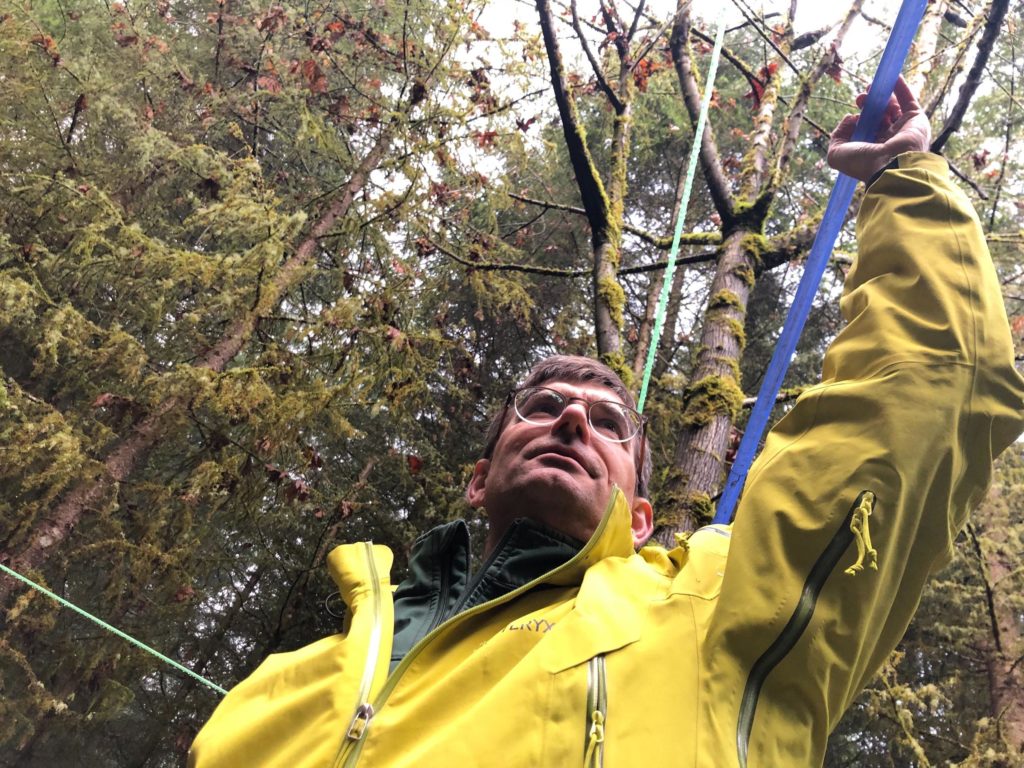
Greg Ettl, a forest ecologist for the University of Washington, shows off the tubing that will carry bigleaf maple sap down the hill using gravity at UW’s Pack Forest. CREDIT: Anna King/N3
Ettl says it’s all about the grade.
“It certainly doesn’t feel natural,” he says. “It’s like what type of mad crazy artist has laid out all these lines? And for what purpose?”
The university’s camouflage-painted pickup now called the “Sugar Sled” will collect the sap from a main tank in the woods and drive the juice downhill to the school’s “Sugar Shack” for further processing.
Ettl says he hopes the concentrated bigleaf maple syrup will be for sale in the University Bookstore later this winter.
Amy Wilson is developing a fresh label and hammering out the nutritional facts with the U.S. Food and Drug Administration and the Washington State Department of Agriculture.
“However, Washington State Department of Agriculture has been wonderful, they have a helpline that you can call,” Wilson says. “And they have the answers immediately.”
But the project also hopes to refine some sticky unknowns with its sweet science: Do the trees make more sap at higher or lower elevations, wet conditions or drier? Are older or younger trees more productive?
“The thing that’s been the most fun for us, is that everyone’s excited about it,” Ettl says. “You know, I get excited about all kinds of things. Then when I tell people, sometimes they’re not excited. But maple syrup, everyone’s excited about maple syrup!”
“Tastes How It Feels Up There”
It’s a flat-grey Seattle morning and a freshly built fire wafts meaty smoke into the commercial kitchen of Canlis.
Brady Williams whips cream with his heavily tattooed arm. He’s the executive chef of the celebrated restaurant overlooking Lake Union. A few months ago, he won the James Beard Award for best chef in the Northwest.
He likes the cream to drip off the whisk like Elmer’s Glue. Stop whisking when it barely comes together, he suggests.
Cream is really just the conveyance for Neil’s Bigleaf Maple Syrup. Williams purposely spoons a glossy dollop into a bubble-shaped globe. The cream nestles aside Idaho sturgeon caviar and stroopwafles sandwiched with miso caramel; it’s black pearls on pearl white.
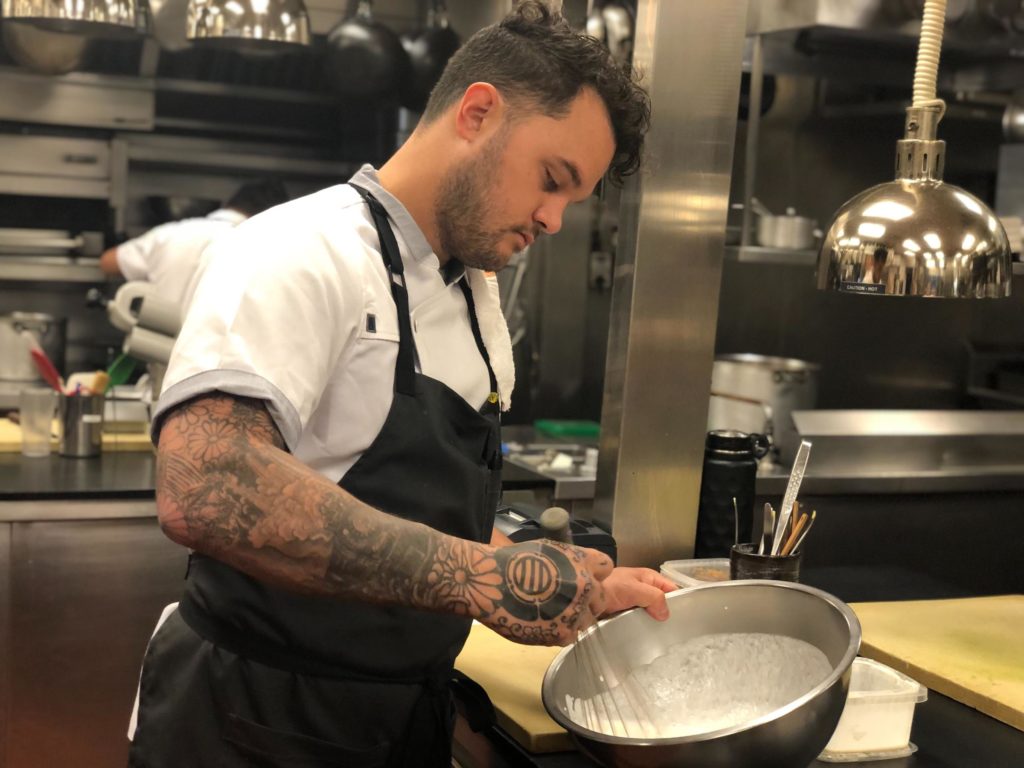
Brady Williams, the executive chef of Canlis in Seattle, whips together cream seasoned with bigleaf maple syrup for a caviar dish. He recently won a James Beard award. CREDIT: Anna King/N3
“Fine dining doesn’t necessarily mean luxury ingredients or expensive stuff,” Williams says. “You just want to serve the most-considered ingredients.”
Neil McLeod has single-handedly stirred a hunger for Northwest-sourced maple syrup.
Canlis’ kitchen is bringing the stuff in by the gallon. Williams alone has created nearly 25 dishes that featuring bigleaf maple syrup.
The state has given McLeod’s operation a food processing permit — just $92 a year — and will do food safety inspections as the company builds its restaurant business.
Williams dips a finger into the syrup and tastes: vanilla, caramel, smoke.
“We want to support local farms and artisans as much as possible,” Williams says. “When I taste this (syrup), I taste the terroir from the Skagit Valley or northern Washington. To me, it tastes how it feels up there.”
State Of Things
The U.S. Department of Agriculture, the Washington Department of Natural Resources, and the state’s Department of Agriculture have been scrambling to keep up with the new industry.
The USDA’s National Agricultural Statistics Service doesn’t keep records yet on bigleaf maple syrup production, according to Christopher Mertz, director of the Northwest regional office.
There aren’t any known commercial operations in Oregon, according to the Beaver State’s Department of Agriculture. But the 2012 Census of Agriculture did record four farms in Washington, likely hobbyists, with a total of 36 taps. UW plans to install 700 experimental taps in Pack Forest this year. And in Canada, three distinct tribes of the Hupacasath First Nation — Muh-uulth-aht, Klee khoot aht and Cuu-ma-as-aht — make commercial syrup together on Vancouver Island. There is even an annual bigleaf maple syrup festival on Vancouver Island, B.C.
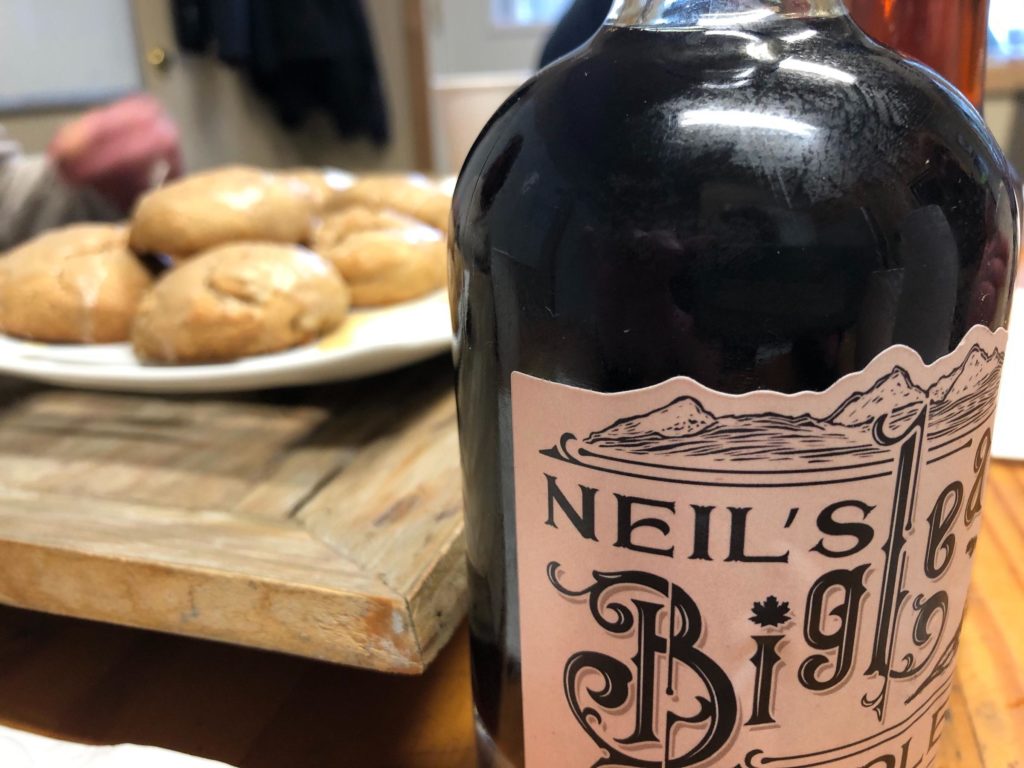
In Acme, Washington, a bottle of Neil’s Bigleaf Maple Syrup and some maple scones await taste testers. The finished syrup mostly ends up in Seattle restaurants. CREDIT: Anna King/N3
But with 1,200 taps already pulling sap, McLeod’s farm is the Northwest’s biggest commercial player. Next year, he plans to install 10,000 more taps.
Beyond his own land, McLeod is looking to expand into state lands, where there are more maples. In Wasington’s Whatcom County, McLeod’s syrup operation paid a $500 administrative fee for a special use permit to tap sap on about 225 acres of DNR land this season. It’s similar to the type of permit someone would get for hunting mushrooms or harvesting tree boughs. Both the state and the sap collectors will reassess and see if the contract penciled out.
Tap Out
There’s just one big bigleaf problem.
As money grows on trees, many bigleaf maples from Vancouver Island to California are declining for mysterious reasons.
Dan Omdal has studied this problem for two decades. But after all his effort, the top forest pathologist for Washington’s Department of Natural Resources hasn’t nailed a lone culprit.
A bit like a large-animal vet for trees, he’s done core samples, dug at the roots, chopped into dead trees, all to figure out what’s ailing them. But like colony collapse with honeybees, the problem is more complex than a single virus, fungus or insect.
The trees generally mature well, then start growing smaller leaves, which yellow and drop at odd times, then branches die back and eventually the entire tree dies right where it stands.
Omdal has investigated funguses, viruses, bacteria and pests, but there is no single ringing bell.
In the past decade, increasing hot, dry summers might be stressing maples enough to leave them vulnerable to attackers.
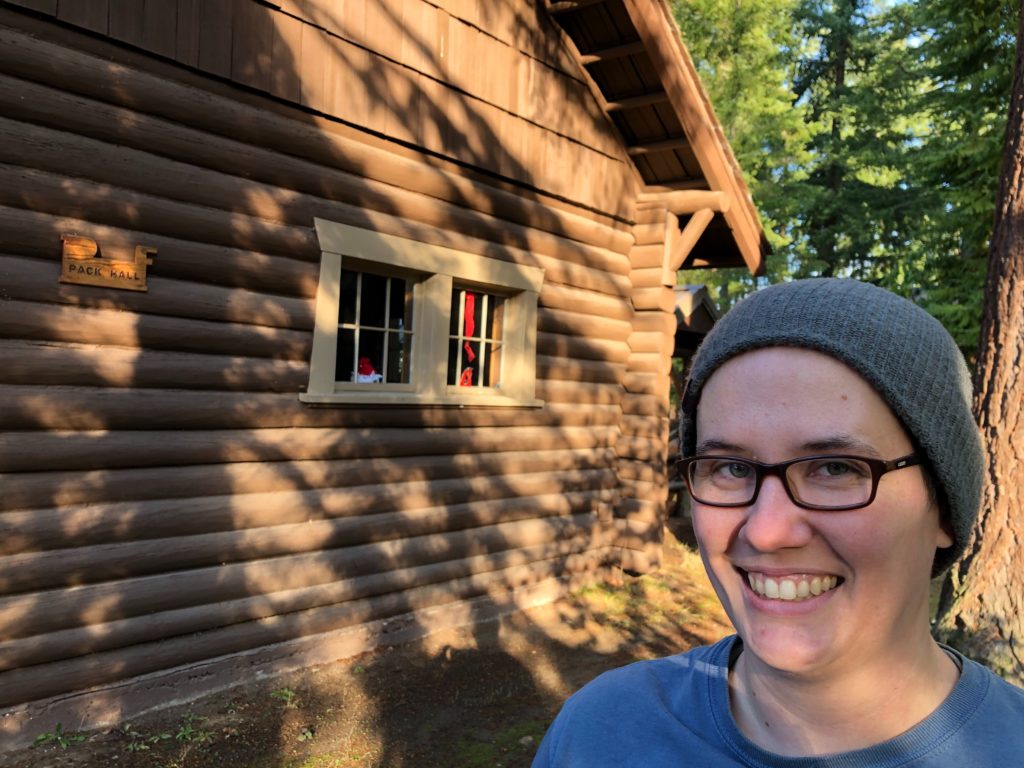
Amy Wilson, an education coordinator with the University of Washington, shows off the Pack Hall at UW’s Pack Forest. The university might use the lodge as an emblem to brand its new bigleaf maple syrup. CREDIT: Anna King/N3
Omdal points to a recent study of tree cores carried out by him and a team from UW.
He says although there were some older trees that have been going downhill for sometimes 30 and 40 years, most of the sick trees they studied started to decline in just the last five to seven years.
“Decline is a recent phenomenon for them,” Omdal says.
He estimates that up to a third of bigleaf maple trees are affected by this condition in western Washington.
And he thinks the maple trees that are most at risk might be in drier and warmer sites because they can’t tolerate the West Coast’s increasing droughts. It all adds up to a shrinking range for bigleaf maples.
Like the Eastern maple syrup industry, climate change projections could mean that many bigleaf maple trees tap out in the future.
Tapping itself could stress these trees, too, Omdal says.
The sap runs up the tree carrying sugar and nutrients to buds and leaves, adding growth to the girth of a tree’s rings.
“I think of tree sap as analogous to human blood,” he says. “You’re draining the reserves from that tree. And the cost is often to that tree’s health and vulnerability. It appears that the climate — hotter, drier summers — is creating the conditions that are predisposing these bigleaf maples, making them vulnerable to decline.
“I think tapping maple trees — certainly those that are on warm, dry sites — may also increase their vulnerability to other opportunistic fungi and insects that are looking for a meal,” Omdal says.
It’s too soon to tell, but the benefits of tapping large bigleaf maples might be that greater numbers of trees are left standing and not logged off. If landowners and government can extract some economic benefit from the maples this way, they might even be left in stands where Douglas fir and other species are trucked away.
Dark First Run
Back in Acme, Washington, we’re in dim late-afternoon light beneath the maple trees on Jones Creek.
It’s on the far edge of Neil McCleod’s farm. This creek eventually dumps into the South Fork of the Nooksack River. We stare up into the moss-laden branches arching over this narrow, silvery rill. We hear the pat, pat of fat raindrops on leathery maple leaves. These trees are the old guard — lined up like veterans at a parade.
The farm planted 3,500 more bigleaf maples in spring 2019, hoping to tap into the future potential of this freshly-juiced industry.

Mineral sediment collected in filters dumped into a bowl. The silty byproduct of syrup comes from the minerals in the trees. This batch is going to soap makers for experimentation. CREDIT: Anna King/N3
The first sap of the year is always diluted, so it has to be cooked down further to reach the optimal 66.5 percent sugar. Too little sugar and it could start to mold, too high and the sugar could crystallize. That means early, initially weak sap ends up as even darker and more concentrated syrup to reach that proper percentage. It becomes the rich black-brown of a harsh Italian espresso. When nearly finished and just before bottling, the syrup is run through a filter to extract silty minerals that cloud the molasses-colored sweet stuff.
East Coast syrup is graded on its light color and clarity. But that just doesn’t work with what comes from bigleaf maples, McLeod says.
Each of his “vintages” of sap produce slightly different colored syrups. But the chefs he supplies particularly like that darker, first-run concentrated syrup.
Bigleaf maple sap runs especially heavy when there’s a freezing night, followed by a thaw out in the daytime. Raw sap only lasts a few days in storage before it will spoil, so the syrup making doesn’t wait for Thanksgiving, Christmas or New Year’s celebrations.
In his early life, McLeod was a fisherman in Alaska. He says when his farm’s sap runs, it connects him to a deep sense of time — the universe’s clock.
Mother Nature beckons him out to his sugar barn.
“When the fish were there, didn’t matter what the weather was, you fished or the fish went by,” McLeod says. “Sap is the same thing. I have to be on it. When it’s running I have to be out there, no matter what the weather, no matter what day it is, I’m out there collecting sap.”
Related Stories:
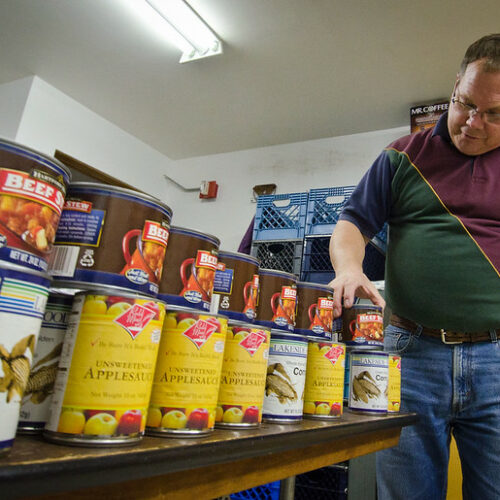
Rural areas hit hard by food insecurity, study finds
Joe Tice, the Tukwila Pantry’s executive director, stocks tables with canned goods at the food bank in Tukwila, Washington. (Credit: Lance Cheung / USDA) Listen (Runtime 1:03) Read Before she
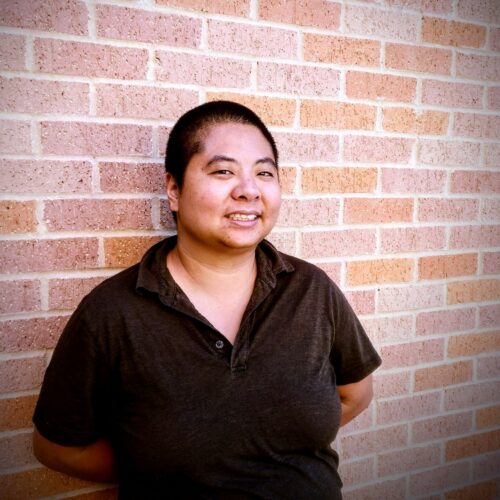
Funding for local poet laureate inspires international collaboration
At food establishments across Redmond, diners this month will find a unique accompaniment to their orders; poems.
Penned by local writers as well as poets from international Cities of Literature, the poems expound on community, harvest and lineage. Redmond’s poet laureate, Ching-In Chen, is leading the project, called Read Local Eat Local, It kicks off on Thursday Sept. 19 in conjunction with the Downtown Redmond Art Walk.
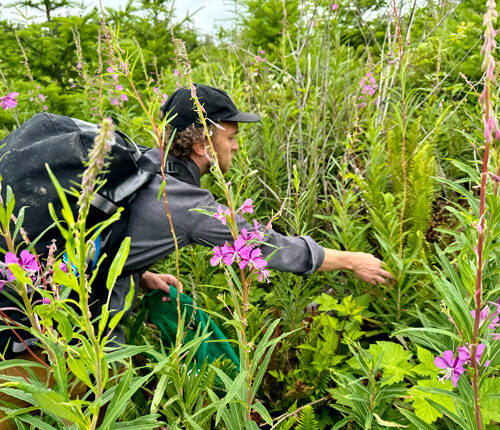
‘Tastes like hard work:’ Inside a foraging hike on the Kitsap Peninsula
Andrew Pogue, co-founder of Fair Isle Brewing in Seattle, reaches for fireweed leaves on a foraging trip. (Credit: Courtney Flatt / NWPB) Listen (Runtime 3:46) Read One craft brewery in

